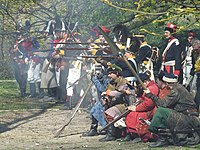Warsaw Insurrection
| Warsaw Uprising of 1794 | |||||||
|---|---|---|---|---|---|---|---|
| Part of the Kościuszko Uprising | |||||||
  Fighting on Krakowskie Przedmieście by Juliusz Kossak (top) Historical reconstruction in the Saxon Garden (bottom) |
|||||||
|
|||||||
| Belligerents | |||||||
|
|
|
||||||
| Commanders and leaders | |||||||
|
Stanisław Mokronowski, Jan Kiliński |
Iosif Igelström | ||||||
| Strength | |||||||
| 3,000–3,500 soldiers, ~2,500 militia[1] |
8,000 soldiers[1] | ||||||
| Casualties and losses | |||||||
| 507 soldiers killed and 437 wounded, ~700 civilians killed |
2,000 or 2,250 to 4,000 killed 1,500 to 2,000 taken prisoner |
||||||
The Warsaw Uprising of 1794 or Warsaw Insurrection (Polish: insurekcja warszawska) was an armed insurrection by the people of Warsaw early in the Kościuszko Uprising. Supported by the Polish Army, the uprising aimed to throw off control by the Russian Empire of the Polish capital city (Warsaw). It began on 17 April 1794, soon after Tadeusz Kościuszko's victory at the Battle of Racławice.
Although the Russian forces had more soldiers and better equipment, the Polish regular forces and militia, armed with rifles and sabres from the Warsaw Arsenal, inflicted heavy losses on the surprised enemy garrison. Russian soldiers found themselves under crossfire from all sides and from buildings, and several units broke early and suffered heavy casualties in their retreat.
Kościuszko's envoy, Tomasz Maruszewski, and Ignacy Działyński and others had been laying the groundwork for the uprising since early 1793. They succeeded in winning popular support: the majority of Polish units stationed in Warsaw joined the ranks of the uprising. A National Militia was formed by several thousand volunteers, led by Jan Kiliński, a master shoemaker.
Within hours, the fighting had spread from a single street at the western outskirts of Warsaw's Old Town to the entire city. Part of the Russian garrison was able to retreat to Powązki under the cover of Prussian cavalry, but most of it was trapped inside the city. The isolated Russian forces resisted in several areas for two more days.
Following the Second Partition of Poland of 1793, the presence of Prussian and Imperial Russian garrisons on Polish soil was almost continuous. The foreign occupation forces contributed both to the economic collapse of the already-weakened state and to the growing radicalisation of the population of Warsaw. Foreign influence at the Polish court, often embodied by Russian ambassador Nikolai Repnin, had been strong for many years; during the partitions of Poland it started to influence the Polish government and szlachta (nobility), and the entire people.
...
Wikipedia
